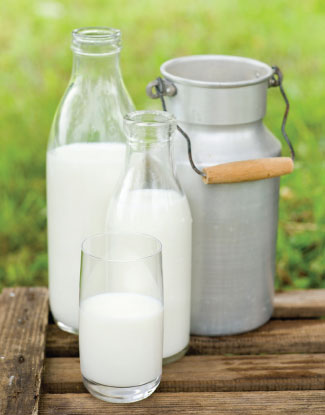In defense of whole-milk dairy
By Nick Rose, M.S.
This article was originally published in January 2013

From 2009 to 2012, whole milk sales at PCC increased from 18 percent of total milk sales to 26 percent. Meanwhile, sales of nonfat milk dropped from 27 percent to 21 percent.
Why are consumers buying more whole-milk dairy? Besides the richer, creamier taste, they may be catching on to the health benefits.
This renewed interest in whole milk is a drastic shift after decades of low-fat shopping by health-conscious shoppers.
High-fat cheeses, whole milk and butter still are perceived as “unhealthy” by the majority of shoppers because of their saturated fat content, while low-fat foods, skim milk and liquid oils are recommended by the nutrition community because of the common belief that saturated fats raise LDL (“bad”) cholesterol and increase the risk of heart disease.
As a result of this demonization of saturated fat, butter consumption dropped steadily throughout the 20th century, as more cooks switched to margarine or liquid cooking oils because these newer fats were more affordable than butter, and even recommended as a healthier choice.
Whole milk consumption declined 33 percent from 1970 to 2005, while sales of lower-fat milks doubled during that same timeframe.
Changing attitudes
Many health professionals now acknowledge the low-fat approach backfired: as our food choices shifted toward low-fat products, sugar intake spiked, as did our total caloric intake. While dietary fat intake has declined over the past 40 years, obesity rates continue to increase, suggesting dietary fat is not the primary culprit.
Only in the last five years has the nutrition community stopped recommending margarine as a “healthy” choice: the trans fatty acids found in partially hydrogenated vegetable oils (not at PCC) raise bad cholesterol, lower good cholesterol, and impair immune function and glucose sensitivity. Liquid cooking oils remain popular, especially olive oil, but saturated fats seem to be making a comeback, even among some (but not all) health professionals.
Unique, healthy fats
Saturated fats may increase blood cholesterol levels, but this doesn’t always contribute to heart disease. For example, coconut oil (rich in saturated fats) raises total cholesterol, but also raises “good” cholesterol (HDL) levels too. Just because a food raises blood cholesterol, that isn’t always a bad thing — only elevated LDL cholesterol levels increase heart disease risk.
Milk fat doesn’t contain the same type of fats as coconut oil, but does have its own unique mix of fats, many not found in any other foods. Organic and pastured (grass-fed) milk contains even higher levels of these unique fats than conventional, grain-fed milk.
You may have heard of two of these healthy fats: conjugated linoleic acid (CLA) and omega-3 fatty acids, but there are other fats in pastured milk that you probably have never heard of, such as vaccenic acid, rumenic acid and trans-palmitoleic acid. Researchers have found that people with the highest levels of trans-palmitoleic acid (a “good fat” in whole milk) in their bodies have lower rates of obesity and diabetes, and that drinking whole milk increases the levels of this unique fat in our bodies.
A recent article published in the European Journal of Nutrition found there isn’t strong evidence to support the theory that dairy fat increases our risks for obesity, diabetes or heart disease — possibly because of these “good” fats found in pastured dairy.
When shoppers switch to organic milk, the result is a win-win situation: cows grazing on grass (as required by USDA’s organic standards) are healthier than cows fed 100 percent grain, and their milk is healthier too.
Whole milk, whole food
Another reason why more shoppers are consuming full-fat dairy products is because whole milk is a whole food. Low-fat and skim milks are missing a natural component, the milk fat.
In a way, it’s like removing the bran and germ from wheat to create a nutritionally inferior product that offers less nutritional benefit.
The fat in dairy also helps with the absorption of fat-soluble vitamins, and whole milk isn’t fortified with vitamins A and D — they’re present naturally. Skim milk, in contrast, is fortified with these vitamins because they are removed with the fat. Perhaps one reason whole-milk dairy sales are on the rise at PCC is because our shoppers like knowing they’re getting their nutrients from a whole food rather than fortified sources.
A whole-food diet contains plenty of cholesterol-lowering soluble fiber from whole grains, minimally processed vegetables and fruits, legumes and seeds — making the cholesterol-raising properties of saturated fats even less of a concern.
Most nutrition professionals still advocate a low-fat approach to dairy, but a few are beginning to change their recommendation to support moderate consumption of full-fat dairy products. I’m not advocating a Paula Dean-style extravaganza of deep-fried butter, but rather offering evidence that when eaten in moderation, and as part of a whole-food diet, whole milk, cheese and even butter are not bad for your health.
Nick Rose is a nutrition educator at PCC.
